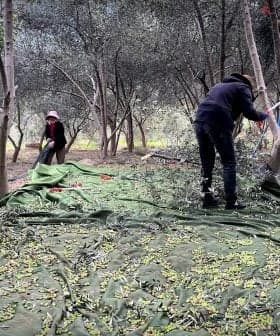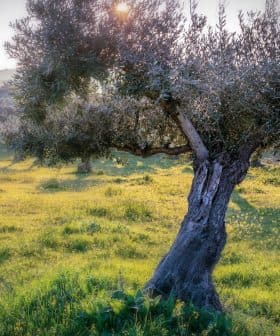India's New Olive Oil Sector
The olive oil market in India is rapidly growing, with production set to increase and demand rising at a rate of 50 percent. This growth presents a significant opportunity for farmers, especially with successful olive cultivation seen in states like Rajasthan and Himachal Pradesh, leading to potential expansion in other states as well. With the market expected to reach Rs. 550 Crores by the end of 2012 and international olive oil manufacturers eyeing the Indian market, investing in olive plantations in India now could lead to significant returns and potentially contribute to a second Green Revolution in the country.

A Farmer in Himachal Pradesh (Photo: Michael Foley)
The olive oil market in India is growing at a rate of 50 percent and production, beginning very soon, will increases this potential and demand.
Olive oil in India is in its nascent stage accounting for just about 0.1 percent of the 3.5 million tons of the branded edible oil market in the world’s second most populous country.
The Indian consumer typically adopts multiple oils at the same time. Oils are matched to recipes and the intensity of usage varies. With this in mind and with imports increasing to 6,798 MT there is a huge growth prospect in plantations. These little green bulbs have the potential to change the fortunes of farmers.
Of course, India has seen olives since the Buddhist era, with the Tripitaka having innumerable references of destroying jaitavans (Olives) by monks after purchasing lands. The first olive plantation experiment was initiated in 1885 at Kashmir, in an Indo-Italian merger. Other experiments included the Indo-Spanish venture for Himachal Pradesh olive plantations. Neither was successful to cultivate large scale olive production.
The olive plantations at Rajasthan began in November, 2006 and last year successful fruits were seen. With the pressing units arriving this season, India is gearing towards successful olive cultivation and the results at all the 7 farms in Rajasthan are indeed very encouraging.
After the success of this initiative, five more states are being researched by the government for olive farming. The Kashmir State is experimenting with the 60 varieties obtained from the U.S., Egypt and Italy. Six varieties have shown very good results. Gujarat olive plantations are also showing successful cultivation. The various olive stations at Himachal Pradesh are increasing rapidly and need the right methods to develop the plantation further. India is now entering into real olive oil production.
Due to campaigns like “Olive it Up” and with companies like Borges and Leonardo investing money to develop their brands, the market is widening and Indians are becoming more educated about the quality of oil. The present distribution of olive oil is 55 percent pure, and 25 percent pomace and 20 percent extra virgin. The retail is certainly dominated by pure olive oil which comprises 62 percent volume and 65 percent of value.
Olive oil is finally creating a niche in India’s edible oil market. Retail is the biggest segment accounting for 75 – 80 percent of sales; the institutional segment is still small accounting for 30 percent of consumption (of which HORECA accounts for 80 percent of the institutional volume). With 60 percent of the national market being controlled by 3 companies in India, and Spain and Italy accounting for 90 percent of the import, there is definitely a potential for other companies and producers to enter the market and more are expected to do so.
There is a need for good consulting before would-be producers decide how to proceed, as a number of factors including the plant variety, climatic and soil conditions and irrigation vary from one state to another and need to be best analyzed. The existence of upcoming consultancies, like Oliva International, having international roots, are an encouraging sign to the plantation sector at India.
On the other hand the government projects should not be just focused on plantations and buy-back operations, but to provide a structured research into plantations and varieties of olives, and so the initiatives of the ROCL for olive plantation are encouraging.
A hectare of land costs just Rs. 15520 to the farmer of the actual cost of Rs.60145, which accounts for almost 75 percent subsidy and only the subsidy amount has to be paid at the nursery by the farmer which is Rs.28.75/pt. Undoubtedly olives are a very beneficial remunerative option of crop diversification and the scenario of exceeding demand for olive oil than supply is not going to be changed in the near future.
Indian olives will be in high demand in India as well as for export to other countries once these upcoming plantations begin to produce. A standard for olive oil is very necessary in India, both for import and production. The FSSAI must open their eyes to this.
The government has approved Foreign Direct Investment in Indian multi-brand retail, thus opening doors for foreign retailers to establish a broad based presence in India. Currently India is considered among the top retail investment destinations by management consultancies.
The Indian olive oil market pegged at Rs 52 Crores until 2006, is now at Rs. 380 Crores. With this expected boom to reach Rs. 550 Crores by the end of 2012 and as per the Indian Olive Association hopes to reach 2,5000 MT in 2020, international olive oil manufacturers and producers are planning their early entry into the Indian market. For sure “NOW” Is the best time to invest in plantations, especially for the new brands which want to gain prominence.
Could these adoptions of new crops and farming techniques be a stepping stone towards the second Green Revolution in India?









